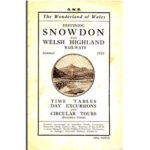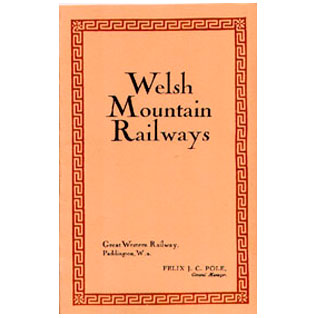Description
It was always “The Cambrian Railways”, never “The Cambrian Railway”, having been formed by the amalgamation by financial necessity of three rather shaky companies and for several years lived, what Arnold Bennett once described in a different context, as “…a life of quiet desperation” narrowly escaping bankruptcy. In 1884, the Company´s bankers insisted on the appointment of a Receiver. The duty fell to John Conacher, Asst- Secretary, later Secretary and General Manager.. By arrangement with the creditors, around seventy different stocks were consolidated into ten, beginning a period of two decades of comparative stability. Starting with Conacher, who later became G.M. of the North British Railway, before returning to the Cambrian as Chairman, services and rolling stock were steadily improved This continued under Alfred Aslett, from 1891 to 1895, when he became G.M. of the Furness Railway, and Charles DennisS who succeeded im, before leaving to take a similar position with the Cardiff Railway in 1910.
The Cambrian was a possessor of several little quirks. Despite being a Welsh railway, its headquarters were in England, at Oswestry, and at first, like the majestic broad gauge Great Western, locomotives carried no numbers, only names. Nearly all the constituent companies’ and early Cambrian locomotives were built and designed by Sharp Stewart of Manchester. These included two very pretty but small inside cylinder 4-4-0s BEACONSFIELD (after thr Prime Minister and HARTINGTON (after the Leader of the Opposition), in 1878. They were amongst the first of this classic British type. When most othe railways were abolishing second class and upgrading third, the Cambrian where second a nd third class were virtually identical (both had wooden board seats, those in second being covered in a thin sheet of American cloth, the Cambrian abolished second and left the thirds alone!
By this time, William Aston had taken charges of the locomotive department, numbers became the order of the day, and names were remove as locos came in for heavy repairs. It has been said that monoglot English drivers struggled with the consonant rich, vowel poor Welsh place names carried, like LLANERCHYDOL and CASTELL DEUDRAETH.
The Cambrian had other peculiarities. Where other companies used clear or red glass in signal spectacles, the Cambrian used violet, with so many miles of route running close to the sea, to avoid confusing shipping. It had one station, Dovey Junction, which could only be approached by train, or by walking along the track. Its sole purpose was to allow passengers to change trains between the coast route, and the line inland to Welshpool. Furthermore, the station itself was in Montgomeryshire, the Station Master’s house in Merioneth and the up distant signal was in Cardiganshire. Another little quirk, before the telegraph had spread throughout the system, was the Tic-Tac used by Station Masters to order the following day’s requirements for empty wagons Hands held pointed together above the head, indicated a van, arams outstretched either side, an open, a finger held vertically each side of the head a cattle truck. Guards were expected to repeat the signal. One unfortunate, on the verandah, enjoying his supper of a nourishing mutton stew, warmed on the van stove, was caught out by a sudden request at an unexpected station , responded automatically, and was rewarded by the view of his meal, lying between the rails and receding into the distance .
Itself the child of amalgamations and takeovers, in later years the Cambrian became noted as the home of quite a flock of “lame duck” lines – narrow gauge and standard gauge light railways which were not good economic prospects, which it either took over or worked. This was because the Directors and major shareholders realised fairly early on, that their investment was not going to produce a fortune, but was vital to the social and economic life of the area which it served. When government legislation made “lock and block” signaling and continuous automatic brakes compulsory, there was no hope of the Cambrian raising the funds by share issues or borrowing on the commercial money market. Directors put their hands in their pockets, lending the money at tiny rates of interest, in the hope that repayment would be made sometime.
The Story Of the CAMBRIAN, is no mere recital of opening dates and list of train services, perhaps because it was not written by a railway expert or even by a professional historian. The author was a local newspaper editor, with access to his paper’s files, and personally to many people of influence, ranging from Earl Vane, to officers past and present of the Cambrian. Consequently the book is rich in anecdote. The young Marquis of Blandford, playing “See the Conquering Hero” on the cornet a piston, standing in front of the smokebox of the locomotive hauling an inaugural train; the first seaside excursion by train to Borth, when a number of men stripped naked and casually walked to the sea – then a number of females followed suit, and every rowing boat in Borth was hired by those wishing a closer view; the village which had a whip round to celebrate the opening of their station, raised £60 in a few hours, then drank it in much the same length of time; or my particular favourite. A prominent local personality objected strongly the huge sum of money which it was proposed to be spent on the Barmouth bridge, and swore that he “ ..would eat the first locomotive to cross it”. Come opening day a few years later, he is showb to a neatly laid table for one on the platform at Barmouth and was asked if “…he would like his locomotive boiled or roasted?”
I have never read a railway history which could reveal to within a foot or so the precise spot where the “First Sod” was cut. This one can. At Welshpool “between the rails of the down line, opposite the signal box.” A remarkable book!





Reviews
There are no reviews yet.